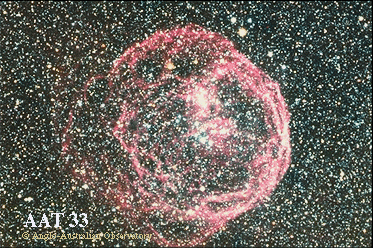Credit & Copyright: Anglo-Australian Telescope
Board
Explanation:
Massive stars (tens of times the mass of the Sun) profoundly affect
their galactic environment. Churning and mixing the
clouds of gas and dust between the stars,
they leave their mark in the compositions
and locations of future generations of stars and star systems.
Dramatic evidence of this is beautifully illustrated
in our neighboring galaxy,
the Large Magellanic Cloud (LMC),
by the lovely ring shaped nebula,
Henize 70 (also known as
N70 and DEM301). It is actually a luminous
"superbubble" of interstellar gas about 300 lightyears in diameter, blown by
winds from hot, massive stars and
supernova explosions,
its interior filled with tenuous
hot expanding gas. These superbubbles
offer astronomers a
chance to explore this crucial connection between the
lifecycles of stars and the evolution of galaxies.
Authors & editors:
Robert Nemiroff
(MTU) &
Jerry Bonnell
(USRA)
NASA Web Site Statements, Warnings,
and Disclaimers
NASA Official: Jay Norris.
Specific
rights apply.
A service of:
LHEA at
NASA /
GSFC
& Michigan Tech. U.
Based on Astronomy Picture
Of the Day
